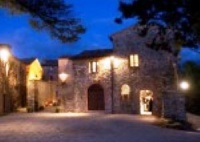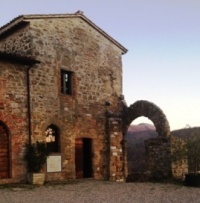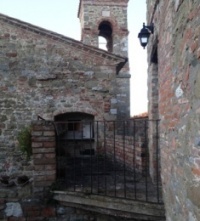Migianella dei Marchesi

 Il piccolo borgo fortificato di Migianella dei Marchesi sorge sul versante est del comune di Umbertide arroccato su un rilievo di 520 m slm, dal quale domina l’ampia valle circostante. La sua collocazione strategica testimonia le antiche funzioni militari e d’avvistamento. Dalla sua particolare forma planimetrica a navetta affusolata, sembra derivare il nome, nel tempo modificato da “navicella” a “Migianella”. Il Castello di Migianella dei Marchesi, fu edificato sulla roccia prima dell’anno 1000, come testimonia l’imponente arco in pietra e i bastioni lungo la cinta muraria. La posizione confinante con la Toscana ne fece una base strategica di controllo esponendola però alle ritorsioni nemiche. La fortezza infatti, fu più volte
Il piccolo borgo fortificato di Migianella dei Marchesi sorge sul versante est del comune di Umbertide arroccato su un rilievo di 520 m slm, dal quale domina l’ampia valle circostante. La sua collocazione strategica testimonia le antiche funzioni militari e d’avvistamento. Dalla sua particolare forma planimetrica a navetta affusolata, sembra derivare il nome, nel tempo modificato da “navicella” a “Migianella”. Il Castello di Migianella dei Marchesi, fu edificato sulla roccia prima dell’anno 1000, come testimonia l’imponente arco in pietra e i bastioni lungo la cinta muraria. La posizione confinante con la Toscana ne fece una base strategica di controllo esponendola però alle ritorsioni nemiche. La fortezza infatti, fu più volte  devastata dalle milizie del Gran Ducato di Toscana in lotta con lo Stato Pontificio. Nel 1478 le truppe di Lorenzo dei Medici e nel 1643 quelle del Duca Farnese, in guerra contro il Papa Urbano VIII, invasero le nostre terre e il Castello e la Chiesa di Migianella furono saccheggiate.Nel 1690 i Monaci Barnabiti o di San Bernardo, detti Cistercensi, furono ospiti del marchesato di Migianella e vi fecero costruire un frantoio. Quattro grosse macine monolitiche sono ancora visibili all’interno delle mura.Agli inizi dell’’800 da convento si trasforma in dimora residenziale. All’interno del borgo è presente la chiesa dedicata a S. Michele Arcangelo: il vano ad aula unica è coperto da capriate lignee. Sopra l’altare c’è una pregevole mostra centinata in pietra lavorata con elementi geometrici e floreali, forse ascrivibile ai secc. XIV – XV. Adiacente alla chiesa si trova la torre campanaria a base quadrata con modanature in cotto all’imposta degli archi che sembrano testimoniare il gusto architettonico del sec. XVIII. La scenografia creata dalla forma, la disposizione dei volumi architettonici, il colore che il tempo ha donato alle pietre, la disposizione delle corti ed il verde boschivo, rendono il piccolo borgo un luogo pieno di magia.
devastata dalle milizie del Gran Ducato di Toscana in lotta con lo Stato Pontificio. Nel 1478 le truppe di Lorenzo dei Medici e nel 1643 quelle del Duca Farnese, in guerra contro il Papa Urbano VIII, invasero le nostre terre e il Castello e la Chiesa di Migianella furono saccheggiate.Nel 1690 i Monaci Barnabiti o di San Bernardo, detti Cistercensi, furono ospiti del marchesato di Migianella e vi fecero costruire un frantoio. Quattro grosse macine monolitiche sono ancora visibili all’interno delle mura.Agli inizi dell’’800 da convento si trasforma in dimora residenziale. All’interno del borgo è presente la chiesa dedicata a S. Michele Arcangelo: il vano ad aula unica è coperto da capriate lignee. Sopra l’altare c’è una pregevole mostra centinata in pietra lavorata con elementi geometrici e floreali, forse ascrivibile ai secc. XIV – XV. Adiacente alla chiesa si trova la torre campanaria a base quadrata con modanature in cotto all’imposta degli archi che sembrano testimoniare il gusto architettonico del sec. XVIII. La scenografia creata dalla forma, la disposizione dei volumi architettonici, il colore che il tempo ha donato alle pietre, la disposizione delle corti ed il verde boschivo, rendono il piccolo borgo un luogo pieno di magia.
 Attualmente il borgo del Castello di Migianella dei Marchesi non ha le fattezze di un suntuoso e maestoso castello. Dispone di ampi spazi sia interni che esterni: terrazze naturali a sbalzo sui boschi che offrono meravigliosi panorami, vecchie stalle e cantine ristrutturate. Il complesso si presenta come un piccolo villaggio rurale fatto di corti, vicoli e casette in pietra. L’aspetto è quello di una residenza di campagna molto ben ristrutturata rispettando i canoni tradizionali ma con un’aria nuova, minimal chic. La casa padronale viene utilizzata qualora sia richiesto di avere uno spazio al coperto ed ospita circa 200 invitati.
Attualmente il borgo del Castello di Migianella dei Marchesi non ha le fattezze di un suntuoso e maestoso castello. Dispone di ampi spazi sia interni che esterni: terrazze naturali a sbalzo sui boschi che offrono meravigliosi panorami, vecchie stalle e cantine ristrutturate. Il complesso si presenta come un piccolo villaggio rurale fatto di corti, vicoli e casette in pietra. L’aspetto è quello di una residenza di campagna molto ben ristrutturata rispettando i canoni tradizionali ma con un’aria nuova, minimal chic. La casa padronale viene utilizzata qualora sia richiesto di avere uno spazio al coperto ed ospita circa 200 invitati.
* * *
The small fortified village of Migianella Marchesi stands on the eastern side of the town of Umbertide perched on a relief of 520 m above sea level, from which dominates the wide valley. Its strategic location, witnessing the ancient military functions and lookout. Since its particular form planimetric shuttle tapered, seems to derive the name, over time changed from "spacecraft" to "Migianella". Castle Migianella Marchesi, was built on the rock before 1000, as evidenced by the massive stone arch and bastions along the walls. The position bordering Tuscany made it a strategic base control though exposing the enemy retaliation. The fortress in fact, was repeatedly devastated by the militias of the Grand Duchy of Tuscany in the fight with the Papal States. In 1478 the troops of Lorenzo de 'Medici in 1643 and those of Duke Farnese, in the war against the Pope Urban VIII, invaded our lands and the Castle and the Church of Migianella were saccheggiate.Nel 1690 Monks Barnabiti or San Bernardo, said Cistercians, were guests of the Marquis of Migianella and had built a mill. Four large monolithic millstones are still visible inside the mura.Agli early '800 convent is transformed into a residence. Inside the village there is a church dedicated to St. Michael the Archangel: the space of a single hall is covered by wooden trusses. Above the altar is a valuable exhibition arched stone carved with geometric and floral elements, perhaps due to the buckets. XIV - XV. Adjacent to the church is the bell tower with a square base moldings terracotta tax arches that seem to bear witness to the architectural taste of the century. XVIII. The set design created by the shape, the arrangement of architectural volumes, the color that time has donated to the stones, the disposition of the courts and the green forest, make the small village a place full of magic.
Currently the village of Castle Migianella the Marquis has the features of a sumptuous and majestic castle. It has plenty of space both inside and outside: natural terraces cantilevered over the woods that offer wonderful views, old barns and cellars renovated. The complex looks like a small village made up of short, narrow streets and stone houses. The appearance is that of a country house very well renovated respecting the traditional but with a new air, minimal chic. The manor house is used if it is required to have an indoor space and is home to about 200 guests.
